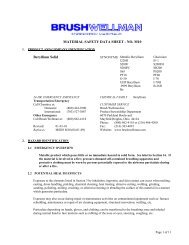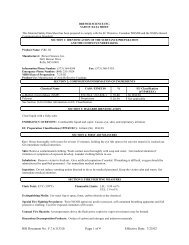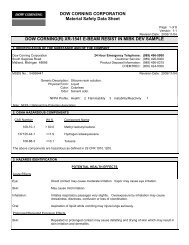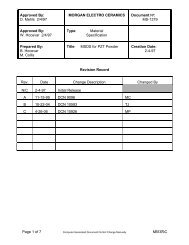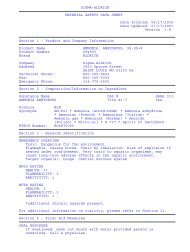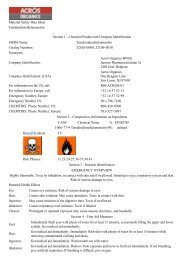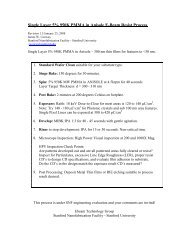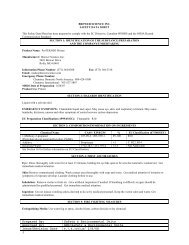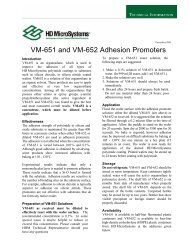EE 410 / Saraswat Handout #3 - Stanford Nanofabrication Facility
EE 410 / Saraswat Handout #3 - Stanford Nanofabrication Facility
EE 410 / Saraswat Handout #3 - Stanford Nanofabrication Facility
You also want an ePaper? Increase the reach of your titles
YUMPU automatically turns print PDFs into web optimized ePapers that Google loves.
<strong>EE</strong><strong>410</strong> / <strong>Saraswat</strong> <strong>Handout</strong> <strong>#3</strong><br />
SECTION 3 - Process Modules<br />
3A. Wafer Cleaning & Resist Stripping:<br />
Proper wafer cleaning is essential, not only for your own process, but for everyone else sharing the<br />
equipment. It is essential that everyone abide by the cleaning protocols to ensure against contamination<br />
and cross-contamination. The clean procedures at SNF are based on procedures commonly used<br />
semiconductor cleanroom from the mid-1980's. Since then, modern electronics production fabs have<br />
eliminated many cleans in order to reduce wafer handling and water consumption, as die yield and<br />
production costs are paramount. However, in research labs, such as ours, flexibility to accomodate a<br />
wide variety of processes and materials is paramount. Thus, SNF relies heavily on wet cleans to allow<br />
broader process margins and guard against cross-contamination.<br />
• Always put a second pair of vinyl gloves over your first pair before handling any wafer cassettes.<br />
Be particularly careful to put on a clean pair of vinyl gloves when handling the cassette before and<br />
after the spin dry. THIS IS VERY VERY IMPORTANT.<br />
• The acid hot pots the wet benches are rather deep. When inserting and removing cassettes from the<br />
acid bath, it is best to put on an acid-resistant glove over your flexiglove and then another<br />
flexiglove over the acid-resistant glove in order to protect your hand when grabbing the cassette<br />
handle. Also, leave the cassette handle in place when immersing the cassettes in the acid bath or<br />
placing them in the dump rinser.<br />
• Bubbling acid can cause wafers to float out of the cassette in the sulfuric hot pot. Always watch<br />
your cassette for signs of severe bubbling on the resist, and agitate as necessary.<br />
3A. 1. Standard Piranha Clean: wbnonmetal<br />
Purpose: To remove trace organics, including non-hardened photoresist.<br />
Method: "Piranha" is a heated mixture of concentrated sulfuric acid, hydrogen peroxide and<br />
water. The sulfuric acid oxidizes organic materials. The peroxide provides the source of<br />
oxygen, yielding CO2 and water as byproducts. Old or heavily-used piranha mixture isn’t as<br />
effective; additional peroxide can restore the activity. Piranha clean is an easy-to-use method<br />
with a very broad processing window. It does, however, mildly oxidize silicon surfaces. Piranha<br />
will corrode non-noble metals. At wbnonmetal, labmembers pour a mixture of 9 parts<br />
concentrated sulfuric acid (about 98% pure acid) to 1 part of hydrogen peroxide (30% in water)<br />
into hot pots which are temperature controlled to 120 C.<br />
When to use: "Clean" class wafers (no metals) which may have organic residues or nonhardened<br />
resist on them. New wafers straight from the storage box should be piranha cleaned<br />
before use (although "prime" wafers go into the storage boxes at the packaging facilities CMOS<br />
clean, plasticizers from the storage boxes will outgas onto the wafers). Wafers with photoresist<br />
can be piranha-cleaned, provided the resist has not been plasma- or bake- "hardened." Wafers<br />
with “hardened” or thick resist (3 microns or greater) should be first plasma cleaned in the<br />
gasonics and then cleaned in piranha.<br />
Revised Jan. 11, 2008 Page 6/47



